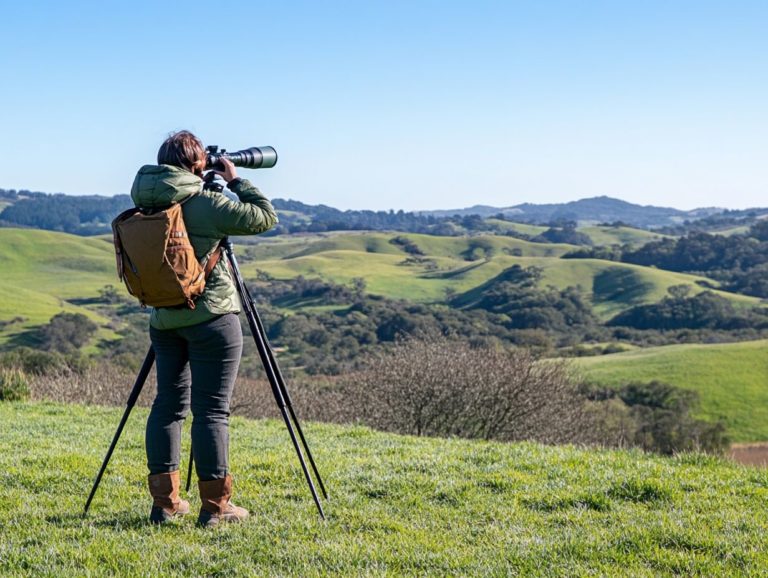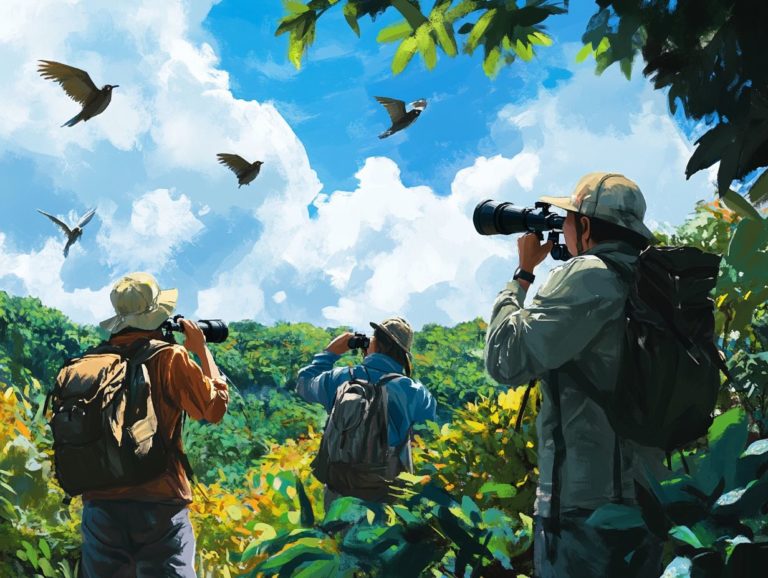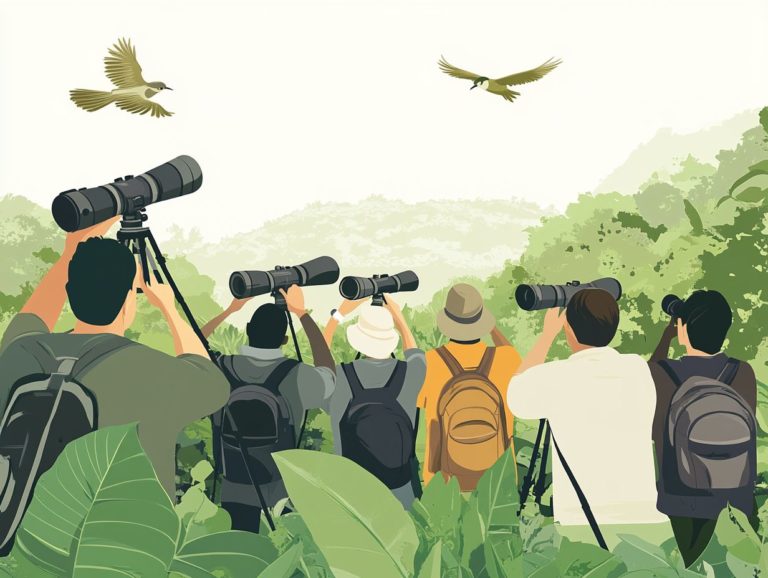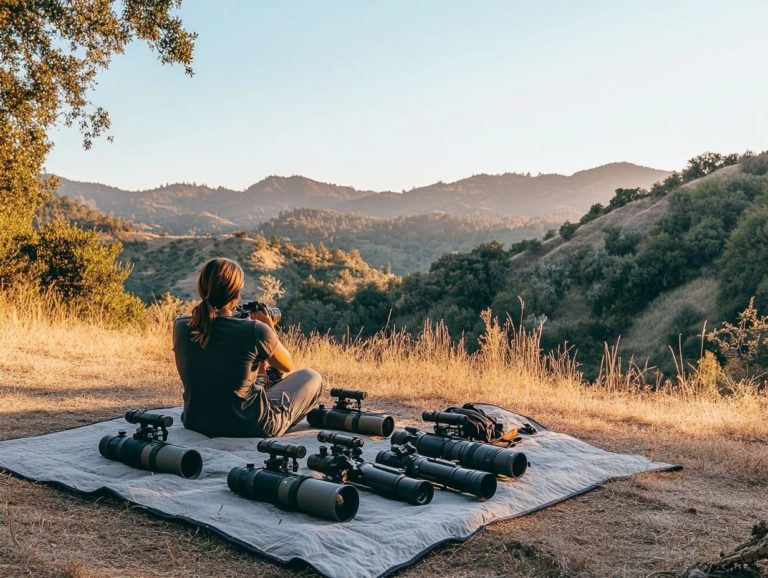Spotting Scope Reviews: Best for Long-Distance Viewing
Choosing the right spotting scope can elevate your outdoor adventures to new heights! With so many options available, it’s crucial to understand the different types and features that can enhance your experience.
When it comes to long-distance viewing, choosing the right spotting scope can truly transform your experience. With a myriad of options at your fingertips, grasping the various types, magnification levels, and optical quality is essential.
This guide delves into every factor you should consider, from durability and portability to pricing and features. Whether you re a birdwatcher, a hunter, or simply a nature enthusiast, this comprehensive resource will guide you in finding the perfect spotting scope for your needs and help you navigate common pitfalls along the way.
Contents
- Key Takeaways:
- 1. Types of Spotting Scopes
- 2. Magnification and Objective Lens Size
- 3. Quality of Optics
- 4. Durability and Portability
- 5. Price Range
- 6. Best Spotting Scopes for Long-Distance Viewing
- 7. Top Features to Look for in a Spotting Scope
- 8. How to Choose the Right Spotting Scope for Your Needs
- 9. Spotting Scope Accessories and Their Importance
- 10. Common Mistakes to Avoid When Buying a Spotting Scope
- 11. Bridging Question: What Makes a Spotting Scope Ideal for Long-Distance Viewing?
- What Are the Advantages and Disadvantages of Different Types of Spotting Scopes?
- How Does Magnification and Objective Lens Size Affect Long-Distance Viewing?
- What Are the Key Factors to Consider When Evaluating the Quality of Optics in a Spotting Scope?
- How Does Durability and Portability Play a Role in Choosing a Spotting Scope for Long-Distance Viewing?
- What Are the Best Spotting Scopes for Different Budgets?
- What Are Some Advanced Features That Can Enhance Long-Distance Viewing with a Spotting Scope?
- What Are Some Common Mistakes to Avoid When Choosing and Using a Spotting Scope?
- Frequently Asked Questions
- What is a spotting scope and why is it best for long-distance viewing?
- What features should I look for in a spotting scope for long-distance viewing?
- What is the recommended magnification range for a spotting scope for long-distance viewing?
- Are there any specific brands or models that are known for their exceptional long-distance viewing capabilities?
- Can a spotting scope be used for other activities besides long-distance viewing?
- What is the average price range for a spotting scope best for long-distance viewing?
Key Takeaways:
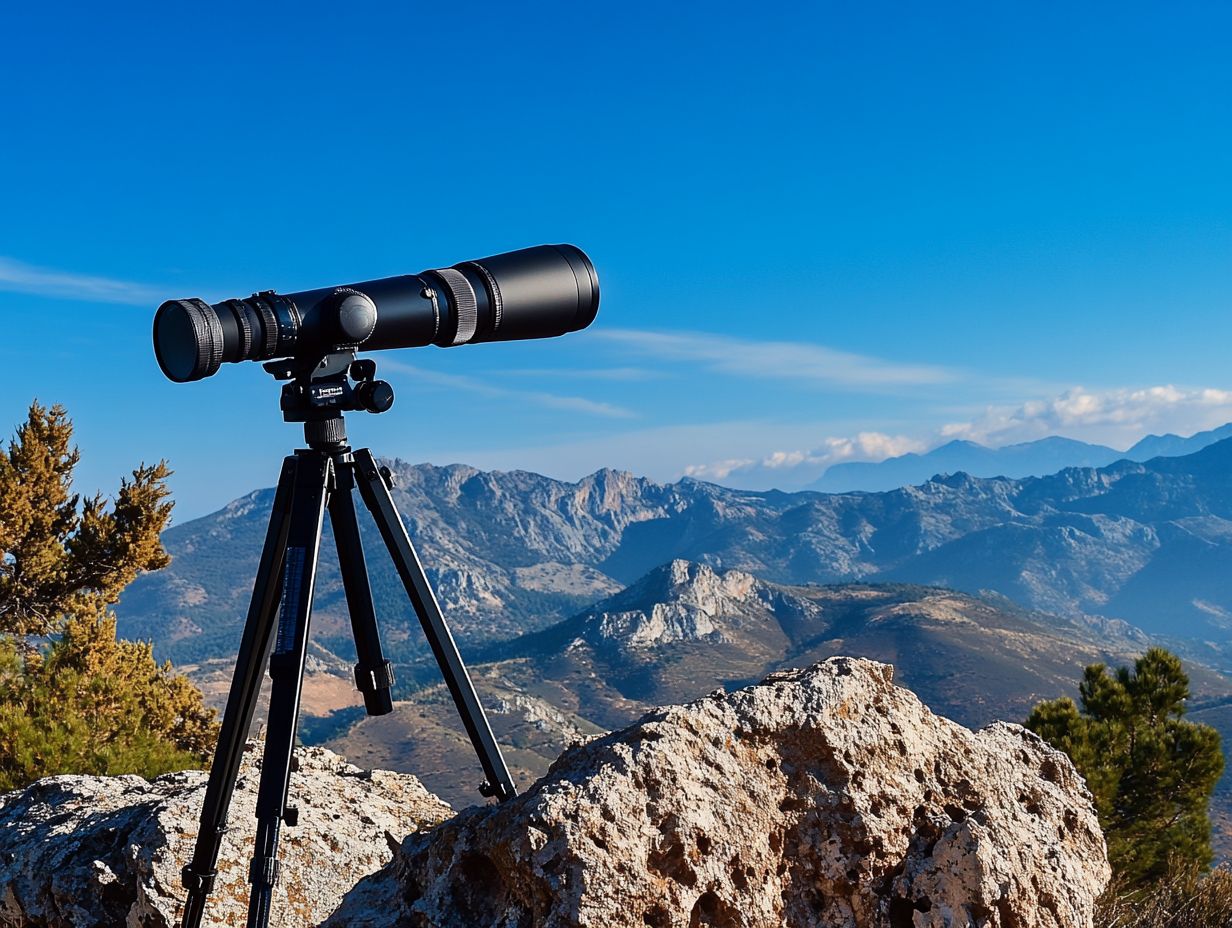
- Choosing the right type of spotting scope is crucial for effective long-distance viewing.
- Higher magnification and larger objective lens size can greatly improve long-distance viewing.
- Investing in high-quality optics is essential for clear and accurate long-distance viewing.
1. Types of Spotting Scopes
Understanding the various types of spotting scopes is essential for outdoor enthusiasts and professionals alike. These devices come in different designs tailored to specific activities.
Whether you re observing wildlife or honing your hunting skills, the right scope can enhance your experience.
The significant differences between full-size and compact models can greatly influence your experience and effectiveness in the field. Full-size spotting scopes have larger objective lenses. They offer superior light-gathering capabilities and enhanced clarity.
This makes them perfect for evening or early-morning observations. Compact scopes focus on lightweight construction and portability, ideal for backpackers.
When choosing your equipment, the right selection becomes paramount depending on your activity be it meticulous birdwatching or precise target shooting. If you re in the market for a premium full-size scope, the Vortex Razor HD features remarkable resolution, while the Nikon Monarch Fieldscope provides versatility and portability for your on-the-go adventures.
2. Magnification and Objective Lens Size
Magnification and objective lens size are key factors that profoundly impact the optical performance and image quality of your spotting scope, particularly when you re striving for exceptional low-light performance during outdoor adventures.
Higher magnification can reveal intricate details when you re observing distant wildlife, but it often narrows your field of view and can make the image a bit shaky, especially at greater distances. For instance, a magnification level of 20x provides stunning detail for spotting animals, yet you ll likely need a stable platform to keep your view steady.
A lower magnification like 8x offers a broader field, which can be invaluable for tracking fast-moving animals an essential advantage when hunting.
The size of the objective lens is crucial for light gathering. Larger lenses, such as those measuring 60mm, allow more light to enter the scope.
This feature significantly boosts visibility in twilight conditions, making it perfect for wildlife watching at dawn and dusk or for hunters waiting for that ideal moment to take a shot.
3. Quality of Optics
The quality of optics in spotting scopes is defined by premium glass and high optical resolution. These features help deliver clearer images and reduce image distortion, which can be distracting for viewers.
As you immerse yourself in nature, the precision and vibrancy of superior optics become your trusted allies. The ability to discern fine details, from the delicate plumage of a bird to the intricate textures of distant landscapes, truly enhances your experience.
Premium glass not only provides high-definition viewing but also ensures that colors remain true and lifelike, elevating every adventure you embark on. These factors significantly impact your evaluations and satisfaction, as you seek equipment that blends durability with outstanding performance, reaffirming your choice with each remarkable sighting.
Now that you understand the key factors, it s time to choose the perfect spotting scope that fits your needs. Don t miss out on those breathtaking views start your adventure today!
4. Durability and Portability
For outdoor enthusiasts like you, the durability and portability of spotting scopes are essential features. These attributes ensure reliable performance in various environments, especially for backcountry hunters who demand ruggedness and ease of transport.
These optical instruments are crafted with weather-resistant materials and robust construction. This allows them to withstand harsh conditions such as rain, fog, and extreme temperatures, enhancing their longevity and reliability in the field.
As you venture into diverse landscapes, the lightweight design makes carrying these scopes a breeze. This makes them perfect for wildlife observation and other outdoor activities.
The compact form facilitates quick setup and adjustment, ensuring a seamless experience during those critical moments when you re trying to spot elusive animals or take in breathtaking panoramic vistas.
This powerful combination of durability and portability enhances your outdoor adventures, allowing you to focus on your experiences without worrying about your equipment holding you back.
5. Price Range
When you re choosing spotting scopes, grasping the price range and overall value is crucial. It helps you strike the perfect balance between affordability and quality to ensure that you invest wisely whether that means opting for budget-friendly models or splurging on premium choices that truly meet your expectations.
In the marketplace, spotting scopes vary widely. You ll find entry-level models aimed at casual birdwatchers, featuring basic optical capabilities at accessible prices.
On the flip side, high-end options come equipped with superior glass and advanced coatings that significantly enhance clarity and brightness.
Budget options typically highlight essential functionality, allowing beginners to enjoy stunning views without straining their wallets. Meanwhile, premium models offer exceptional optical performance along with enhanced durability, making them perfect for serious enthusiasts and professionals who expect to face challenging conditions.
Don t miss out! Weigh these features carefully to find the perfect scope that fits your needs. This thoughtful consideration will enable you to make an informed decision aligned with your specific requirements and budget.
6. Best Spotting Scopes for Long-Distance Viewing
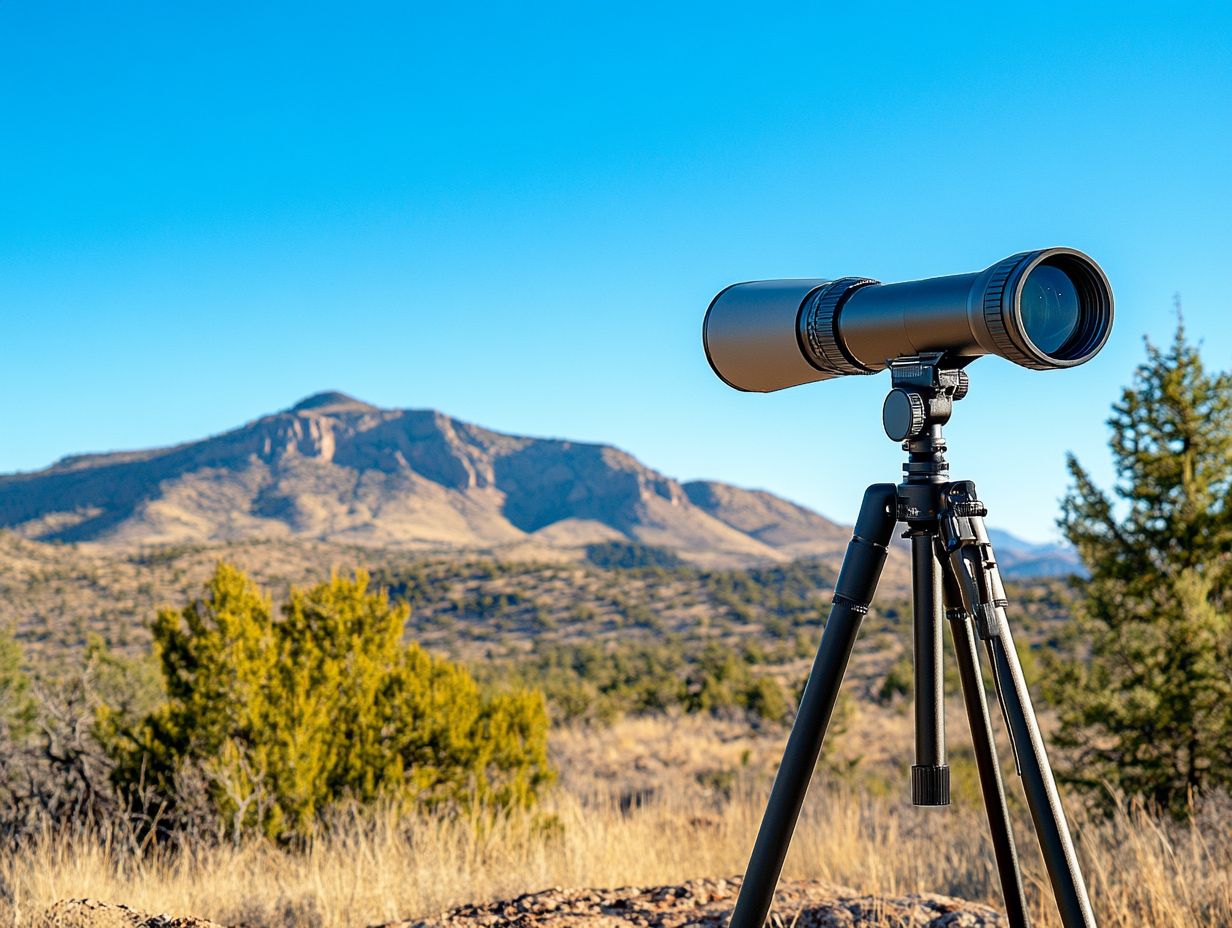
Identifying the best spotting scopes for long-distance viewing requires you to consider various optical performance factors. For those new to the hobby, spotting scope reviews can be invaluable. Models like the Vortex Razor HD and Nikon Monarch Fieldscope stand out thanks to their remarkable clarity and magnification capabilities.
These models also have multi-coated lenses, treated to reduce glare and improve clarity, and robust construction, ensuring durability in a range of environments.
Users often rave about the Vortex Razor HD for delivering bright images even in low-light conditions. The Athlon Cronus G2 garners praise for its superior color fidelity and distortion-free visuals.
Expert evaluations emphasize the importance of pairing these scopes with a stable tripod, which significantly enhances your viewing experience by minimizing shake and ensuring a clear focus. As you explore these options, you ll find that comfort and ease of handling are crucial factors in shaping your preferences.
7. Top Features to Look for in a Spotting Scope
When you’re shopping for a spotting scope, it’s crucial to pinpoint the key features that truly enhance usability and performance. Look for design elements like eyecup adjustment and an angled eyepiece; these details significantly improve your comfort and viewing experience.
This becomes especially vital during those long hours spent observing wildlife or on hunting trips, where fatigue can easily detract from your enjoyment. Keeping an eye on optical resolution is equally important, as it guarantees that the image remains crisp and clear.
This clarity allows you to make detailed observations of distant subjects, whether it’s birds in flight or game animals in their natural habitat.
A user-friendly design, complete with intuitive controls and rugged construction, ensures that you can navigate the device with ease. This makes the spotting scope an invaluable tool, whether you’re a seasoned enthusiast or just starting out.
8. How to Choose the Right Spotting Scope for Your Needs
Choosing the right spotting scope for your specific needs demands thoughtful consideration of consumer insights and expert recommendations. Pay attention to features like how well you can see through the scope and field of view, as these elements can elevate your outdoor experiences.
Start by determining how you plan to use the scope whether for bird watching, hunting, or astronomy. This clarity helps you prioritize the attributes that matter most for each activity.
Budget constraints are a key factor; spotting scopes span a wide range of prices. Finding the sweet spot between cost and quality is essential.
Keep a keen eye on optical performance aspects like magnification capabilities and lens coatings. These elements significantly impact clarity and brightness in various conditions.
Seek expert advice to guide you toward an informed choice, ensuring that the model you select aligns with both your performance expectations and budgetary limits.
9. Spotting Scope Accessories and Their Importance
Spotting scope accessories like protective cases and tripods are essential for enhancing optical performance and ensuring the durability of your equipment. They ultimately elevate your outdoor experience.
These accessories do more than protect your scope from harsh environmental elements; they provide the stability and precision necessary for effective use. A high-quality tripod significantly reduces vibrations, which is particularly advantageous during wildlife observation or hunting, where steady viewing is critical for those fleeting moments.
Sunshades and filters improve visibility significantly, making it easier to discern intricate details in bright conditions. Lens cleaning kits and protective covers enhance clarity and longevity, allowing you to fully immerse yourself in a seamless, enriched viewing experience across various outdoor settings.
10. Common Mistakes to Avoid When Buying a Spotting Scope
Navigating the purchase of a spotting scope can feel overwhelming. It s easy to fall into traps like overlooking user evaluations or skipping thorough tests before making that all-important decision.
Besides these oversights, you might neglect to assess your specific needs. Do you require a compact design for portability, or are you looking for a more robust model suited for stationary use? Commonly, critical specifications like magnification power and lens quality factors influencing performance are overlooked.
To steer clear of these missteps, creating a checklist tailored to your intended use is a game changer! Seek out expert reviews to ensure your final choice aligns seamlessly with your expectations and requirements.
11. Bridging Question: What Makes a Spotting Scope Ideal for Long-Distance Viewing?
An ideal spotting scope for long-distance viewing blends exceptional optical performance with features that enhance image quality. For the best experience, consider the top features to look for in a spotting scope, enabling you to observe distant subjects with clarity and precision, whether you’re engaged in wildlife observation or precision shooting.
Consider key factors like high magnification levels, superior lens quality, and user-friendly ergonomics. For instance, a magnification power of 20-60x allows for detailed views at varying distances, making it an excellent choice for both birdwatchers and hunters alike.
The quality of the lens is critical; fully multi-coated optics dramatically enhance light transmission and contrast, providing vivid, bright images even in challenging lighting conditions. Don t forget about ergonomics a comfortable grip and intuitive focus mechanisms are essential for extended use. Models like the Vortex Razor HD exemplify this balance, marrying top-notch performance with user comfort.
What Are the Advantages and Disadvantages of Different Types of Spotting Scopes?
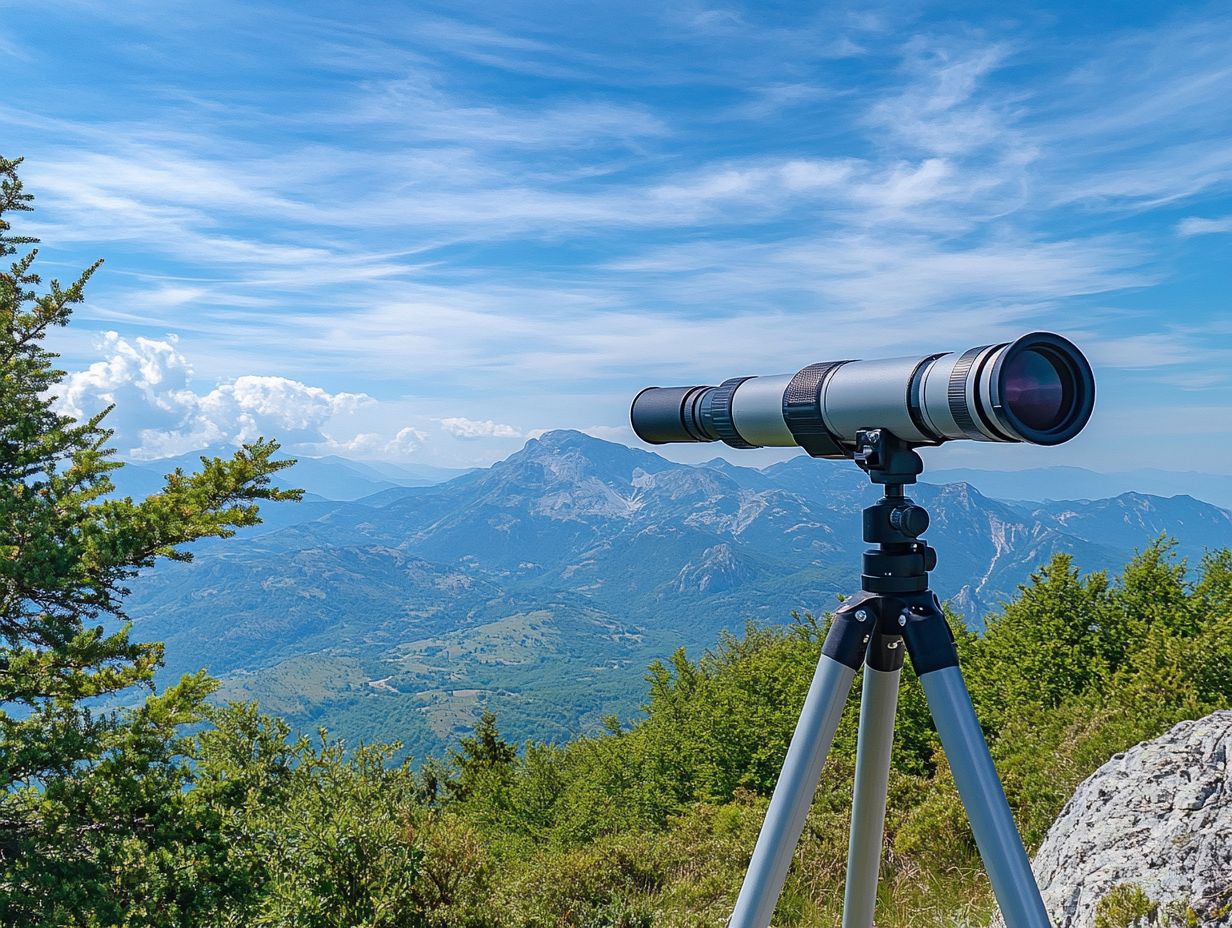
When you re evaluating different types of spotting scopes, like full-size and compact models, understanding their advantages and disadvantages enables you to make informed decisions tailored to your specific outdoor pursuits.
For example, full-size spotting scopes typically deliver superior optical performance thanks to their larger objective lenses, which gather more light. You ll enjoy bright, clear images, especially when light is low. These scopes excel in activities such as birdwatching, hunting, and long-range shooting, where every detail matters. They are great for serious outdoor enthusiasts!
Conversely, compact spotting scopes are all about portability. They re perfect for hikers and travelers who need lightweight equipment without sacrificing too much optical quality. However, keep in mind that they may not match the brightness and clarity of their full-size counterparts.
Ultimately, your choice between the two will hinge on your priorities whether you seek enhanced optical performance for extended viewing or the convenience and ease of a portable scope.
How Does Magnification and Objective Lens Size Affect Long-Distance Viewing?
Magnification and objective lens size are pivotal elements in long-distance viewing, shaping the clarity and detail of distant subjects. This is crucial for pursuits such as wildlife observation and precision shooting.
Picture spotting a majestic eagle soaring through the sky. Higher magnification zooms in for a closer look, but be warned without sufficient stabilization or a larger objective lens, that image might turn shaky or lose definition. On the flip side, a generous objective lens diameter significantly improves light intake, delivering brighter images, especially during the enchanting hours of dawn or dusk when wildlife is most active.
In shooting sports, the balance shifts slightly; a lower magnification grants you a wider field of view, making it easier to track targets swiftly. However, a higher magnification provides the precision needed for those far-off shots. Grasping these intricacies can profoundly enhance your overall experience, allowing you to engage with your environment like never before.
What Are the Key Factors to Consider When Evaluating the Quality of Optics in a Spotting Scope?
To evaluate optics quality in a spotting scope, consider key factors like optical resolution, premium glass materials, and the minimization of optical aberration to achieve superior image performance.
These elements affect clarity, sharpness, and your enjoyment during outdoor activities like birdwatching or stargazing. For instance, premium glass materials such as ED (extra-low dispersion) glass work wonders in reducing color fringing, enhancing the color fidelity of your images.
Paying attention to optical resolution is important to ensure that your spotting scope delivers clear details, even at longer distances, which is essential for observing wildlife or distant landscapes.
You should also weigh factors like optical coatings, which can improve light transmission and reduce glare, ultimately offering a more vibrant viewing experience. A great spotting scope balances these features, helping you enjoy nature.
How Does Durability and Portability Play a Role in Choosing a Spotting Scope for Long-Distance Viewing?
When choosing a spotting scope for long-distance viewing, durability and portability should be at the forefront of your mind. For a comprehensive understanding of what to look for, consider spotting scope selection factors that significantly influence how well the scope performs in various outdoor environments and its reliability while you’re on the move.
Look at the materials used in the construction and overall weight as key factors in how well your spotting scope can endure tough conditions while remaining lightweight for easy carrying.
Scopes crafted from materials like carbon fiber or high-quality aluminum strike a commendable balance between sturdiness and portability.
If versatility is what you seek, look for models that feature protective elements such as rubber armor and waterproof seals. This way, you ensure longevity without compromising on your ability to transport the scope comfortably.
Highly regarded models like the Vortex Diamondback or the Leupold SX-1 McKenzie come highly recommended, delivering superb performance in both durability and portability.
What Are the Best Spotting Scopes for Different Budgets?
Finding the best spotting scopes for your budget involves evaluating a range of options, from budget-friendly models to premium picks, ensuring you strike the perfect balance between quality and price.
As you navigate the spotting scope market, focus on models tailored to your specific needs, whether you re into birdwatching, hunting, or stargazing. If you’re working with a tighter budget, you’ll want to prioritize features like durable construction and good optical clarity, so you can dive into your adventures without breaking the bank!
For those in the mid-range category, versatility becomes key; you might seek scopes that offer greater zoom and stability for a variety of activities.
High-end users, on the other hand, will likely expect advanced features such as superior low-light performance and exceptional image quality, ensuring optimal viewing experiences no matter the environment.
Understanding these priorities can significantly refine your decision-making process.
What Are Some Advanced Features That Can Enhance Long-Distance Viewing with a Spotting Scope?
Advanced features in spotting scopes, such as eyepieces designed for better targeting and innovative eyecup adjustments, can elevate your long-distance viewing experiences by enhancing comfort and precision.
The use of high-quality glass and advanced coatings minimizes glare and maximizes light transmission, allowing you to see clearer images even in challenging lighting conditions.
Adjustable magnification offers you the flexibility to zoom in on distant subjects with remarkable detail or broaden your field of view as needed. It’s also important to consider optical resolution for the best image quality.
Modern spotting scopes often feature rugged, waterproof designs, ensuring durability and reliability in a variety of environments. This blend of optical advancements and ergonomic designs not only enriches your visual experience but also enables you to engage with nature, hunting, or wildlife observation with elevated efficiency and enjoyment.
What Are Some Common Mistakes to Avoid When Choosing and Using a Spotting Scope?
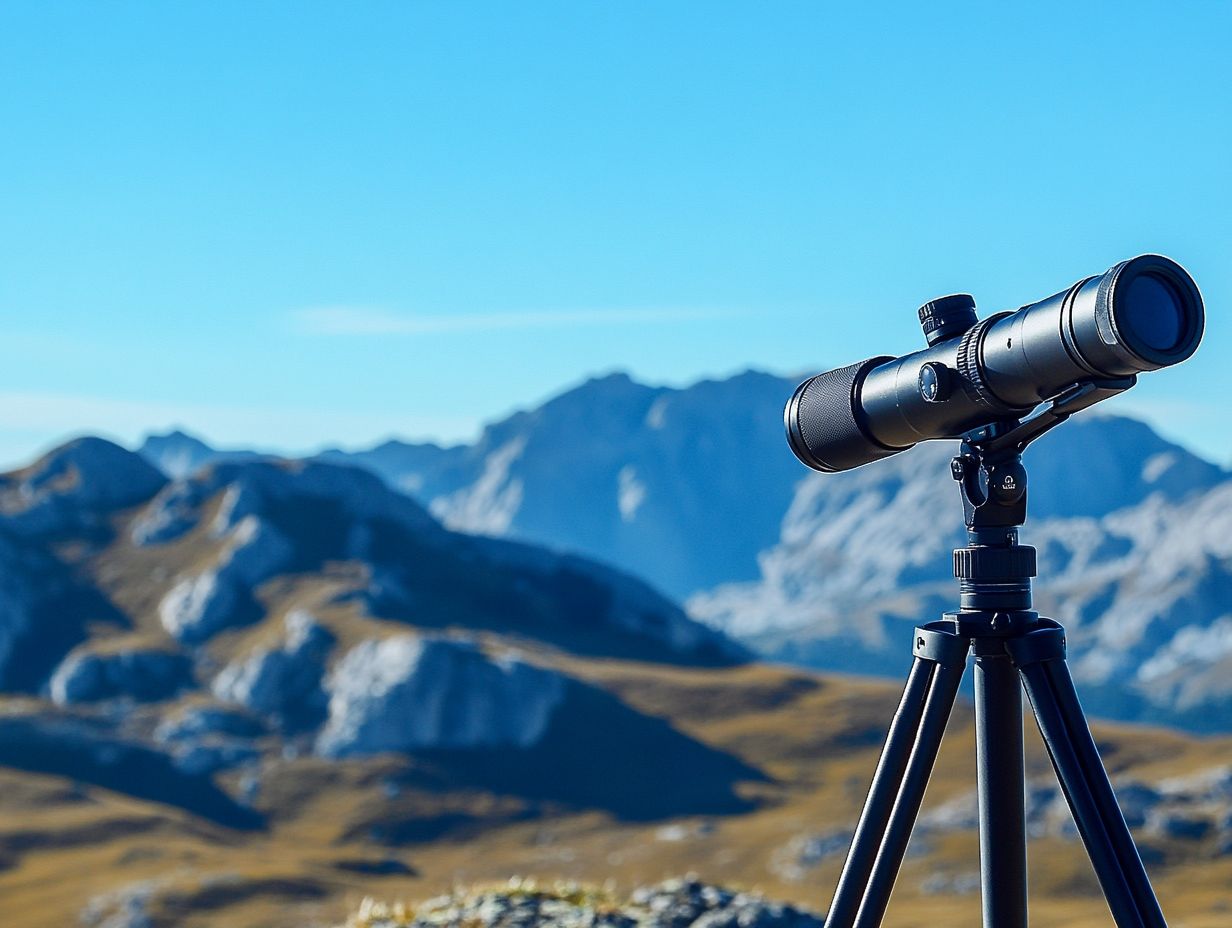
Choosing and using a spotting scope can be fraught with common mistakes that you might encounter, such as overlooking essential specifications and failing to adequately test the optical performance and mechanical performance before making a purchase.
It s easy to be lured in by marketing claims instead of diving into firsthand user evaluations, which can lead to disappointment later on.
It s crucial to recognize that not all spotting scopes are created equal; differences in magnification, lens quality, and field of view significantly impact their overall performance.
To sidestep these pitfalls, seek out comprehensive reviews, conduct side-by-side comparisons in stores, and meticulously check return policies in case the scope doesn t meet your expectations.
Taking the time to familiarize yourself with technical specifications can greatly enhance your selection process, leading to a more informed decision and a satisfying experience.
Frequently Asked Questions
What is a spotting scope and why is it best for long-distance viewing?
A spotting scope is a portable telescope. It’s perfect for birdwatching, hunting, or even stargazing.
It excels at long-distance viewing due to its high magnification and enhanced image clarity.
What features should I look for in a spotting scope for long-distance viewing?
For the best long-distance viewing, seek scopes with high magnification and large objective lenses.
High-quality coatings enhance brightness and clarity.
What is the recommended magnification range for a spotting scope for long-distance viewing?
A magnification range of 20x to 60x is ideal. This offers flexibility for various distances.
Are there any specific brands or models that are known for their exceptional long-distance viewing capabilities?
Brands like Vortex Optics, Swarovski Optik, and Leupold are top picks.
They provide durable scopes with excellent lenses.
Can a spotting scope be used for other activities besides long-distance viewing?
Spotting scopes are versatile! They work well for astronomy, nature observation, and target shooting.
What is the average price range for a spotting scope best for long-distance viewing?
Expect to pay between $200 and $1000 for a quality scope.
Choose one that fits your budget and needs.

